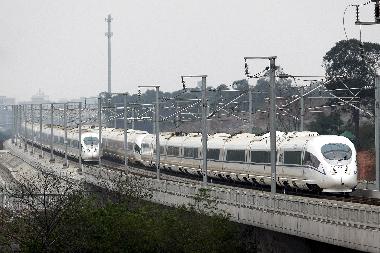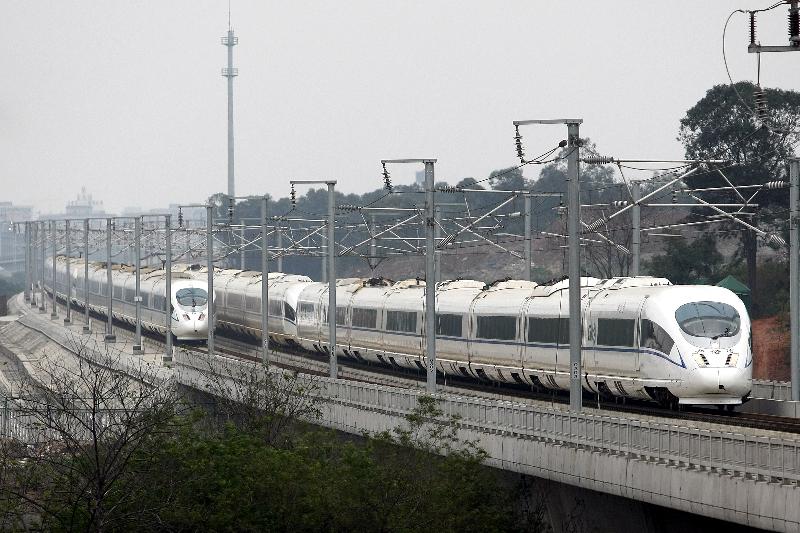News from Chinese Railways Three high-speed railway lines have been put in operation in China



The high-speed railway line Lanzhou – Urumqi, the construction of which began in January 2010, is the first high-speed railway in China, built in the high-mountain region of the Gobi desert chain. This line crosses the provinces of Gansu, Qinghai and Xinjiang Uygur Autonomous Region. The total length of this railway is 1776 km, and it has 21 stations (departure station is West Station of Lanzhou city, and destination station is South Station of Urumqi city). The design speed is 250 km/h, the total enroute time is not more than 12 hours, that is as almost twice shorter in comparison to the ordinary train running time. Introduction in operation of a high-speed railroad line of Lanzhou – Urumqi has allowed to improve railway system structure in the Western China and has reduced time distance between north-west and central provinces of the country that is of great importance for the Western China development and results in an increase of the Eurasian continental railway line throughput.
The high-speed railway line Guizhou – Guangzhou, which construction began in October 2008, crosses the provinces of Guangdong, Guangxi and Guizhou. Its total length is 857 km with 20 stations (departure station - North Station of Guiyang, and destination station is South Station of Guangzhou). Designed speed is 300 km/h. The running time of the trains reduced to 4 hours 9 minutes in comparison with 21 hours in the past.
The high-speed railway line Nanning – Guangzhou, which construction began in November 2008, has a length of 577 km with 13 stations on it (departure station - East Station of Nanning, destination station - South Station of Guangzhou). Designed speed is 250 km/h. The running time of the trains was cut to 3 hours 19 minutes as compared to 13 hours before. With operationalization of these two lines the railway system structure in Western-Central and Southern China has considerably improved, as well as the time distance between Western-Central and Southern-Western areas and the region of Chudzjan delta has significantly reduced. This has opened new possibilities for the development of trade-economic ties and regional cooperation between these three provinces of China.
Progress in the development of heavy haul transportation on KZD
Since July 2014 the Chinese Railways have successfully conducted comprehensive test runs of a heavy haul train with a 30-ton axle-load on a new railway line in Shanxi province, which is a new achievement in the field of heavy haul traffic technologies for KZD.
At present the Chinese Railways widely apply an axle load of 23 tons for the freight wagons. For the past few years, in order to accelerate the heavy haul traffic development, the Chinese Railways have successfully introduced an integrated technology of heavy-haul train operation with an axle load of 25 tons based on the domestic innovative developments. These technologies are successfully applied on Datong – Qinhuangdao line, dedicated for coal transportation, and other lines with heavy haul traffic. On the basis of these researches, to implement the project for the construction of a new railway line in the Southern-Central region of the Shanxi province, new technologies have been comprehensively developed to ensure heavy-haul train movement with an axle load of 30 tons. For the first time also developed have been new locomotives and freight wagons with the same axle load, electro-pneumatic braking systems, technology of a single-phase electrical supply, power-saving traction transformers, comprehensive technologies for the construction of bridges, tunnels and permanent way, laying of rails and switches.
The integrated tests in the field of heavy haul transportation covered 6 systems, 20 specialised subjects and 77 objects, including rolling stock, engineer structures, signaling, blocking (SFT) and communications equipment, systems of power traction and power supply, vibration and noise protection. During the tests systematically checked have been safety procedures, compatibility and applicability of stationary objects and mobile devices in the conditions of heavy-haul traffic with an axle load of 30 tons. The test running distance has reached 100 thousand km up to now. The results of the comprehensive tests have laid down a strong basis for operationalization of heavy-haul traffic with an axle load of 30 tons on the Chinese Railways network.
